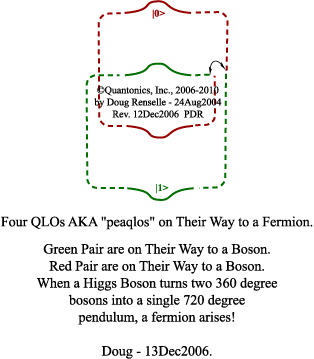 |
Students of Quantonics we ask you to imagine each of four fluxoid's single QLO as a
|
Allow us to offer a more extensive quote from page 153, (this text is from p. 215 from Mae-wan's 2nd edition) a quote relevant to our 2003-2004 feuilleton Chautauqua: Any quantum system described "...as a domain of coherent activities, opens the way to envisaging individuals which are aggregates of individuals, as, for example, a population or a society engaging in coherent activities. As coherence maximizes both local freedom and global cohesion, it defines [inter]relationship[s] between the individual and the collective which has previously been deemed contradictory or impossible. The 'inevitable' conflict between the individual and the collective, between private and public interests, has been the starting point for all social as well as biological theories of western society. Coherence tells us it is n¤t so 'inevitable' after all. Eminent sociologists have been deploring the lack of progress in sociology, and saying that it is time to frame new questions. Perhaps sociology needs a new set of premises altogether. In a coherent society, such conflicts do n¤t exist. The problem is how to arrive at such an ideal state of organization that in a real sense, nurtures diversity (and individuality) with universal love." (Our brackets, bold, quantization of 'not,' and italicization of thelogos. We left out footnotes 22 and 23 from Mae-wan's 2nd edition. We corrected US spelling to 'premises.' All other punctuation and marks are hers.) Percy Bysshe Shelley would love this! Doug - 12Mar2004. |